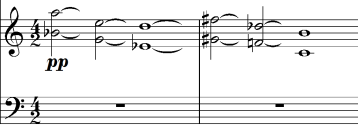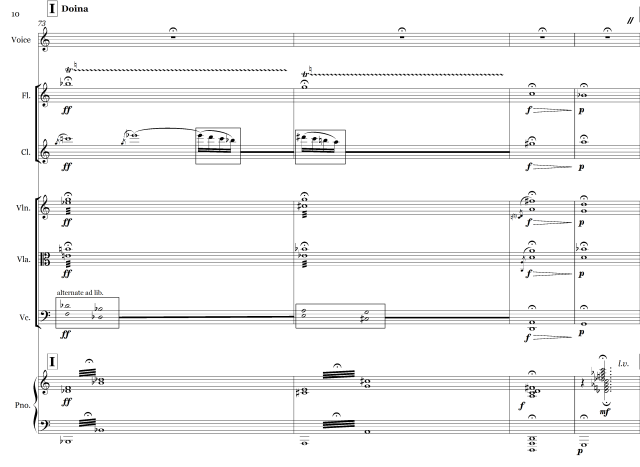In my last post I described a large-scale project of which, at the time, I had completed only a few fragments. As I hinted in the last post, I anticipate this that this project will take several years to complete. Lately I have been working on another long-term project: a setting of five Nostradamus quatrains, of which two will be premiered on February 13 as part of the Oak Bay New Music Festival.
When I was 15, I found the ominously-titled Final Prophecies of Nostradamus in a used bookstore called The Flaming Novel. The shop, located in a strip mall parking lot in Apache Junction, Arizona, lived up to its name by falling victim to a fire sometime later. The book features the text of Nostradamus’ Prophéties (originally published 1555-66), comprised of 941 quatrains organized in ten Centuries, mostly in Middle French. It features uninspired translations and misguided interpretations by Erika Cheetham. Cheetham did write a fairly interesting introduction however, and I learned that Nostradmaus was born Michel de Nostradame to a Jewish family in Provence. Regardless of their reputation as prophecies, most of the quatrains also are of dubious value as poetry; many are lists of 16th century states, cities and towns (e.g. VIII.LII et al). That being said, there are a handful of quatrains that struck me as beautiful when I first read them, especially quatrain VIII.XCVI (the text from this 1566 edition rather than from Cheetham’s book):
VIII.XCVI: La ſynagogue ſterile
La ſynagogue ſterile ſans nul fruit,
Sera receuë entre les infideles,
De Babylon la fille du porſuit,
Miſere & triſte luy trenchera les aiſles.The sterile synagogue without any fruit
Will be received by the infidels,
The daughter of the persecuted one of Babylon,
Miserable and sad they will clip her wings.
The explicitly Jewish content of the poem and its powerful imagery convinced me to attempt a setting, which I began in late 2006. The piece began as an attempt to reconcile the traditions of Klezmer and serialism, each of which I was beginning to discover at the time. I came up with the following piano dyads, which use all twelve notes of the chromatic scale, and derived two tone rows from them:
I ended up setting only the first line of the poem before abandoning it in 2007. The first line of the original version for voice and piano uses a mixture of Klezmer modality and serialism, including this representative passage:
Untilthe end of 2007, I continued setting fragments of several other quatrains, but never completed any of them.
The next step in the development of this project took place in fall 2012 when, as part of Ron Kuivila’s composition seminar at Wesleyan University, we were assigned to write for an ad hoc ensemble of Connecticut musicians: namely voice, tuba, percussion, harp, accordion, viola and double bass. This highly unorthodox instrumentation, particularly the tuba, accordion and bass, reminded me of a Klezmer band, so I decided to complete my earlier setting of La ſynagogue ſterile for the ensemble. In order to emphasize the Jewish content of the work, I decided to intersperse a doina between the lines of the quatrain. The doina stems from sketches I wrote for solo tuba in 2010-11, which I called Der Levoner Doina (The Lunar Doina). I completed this version of La ſynagogue ſterile in November 2012 and it was subsquently performed and recorded at Wesleyan:
I decided to revisit my Nostradamus project recently, because I felt as though La ſynagogue ſterile was not substantial enough a piece in its 2012 incarnation, and its unusual instrumentation meant that it might not be performed again in the foreseeable future. When the opportunity arose to write a piece for a chamber ensemble of voice, flute, clarinet, violin, viola, cello and piano for the 2016 Oak Bay New Music Festival, I jumped at the chance to adapt La ſynagogue ſterile for the new instrumentation, and also to expand the work to include two additional movements. I had come up with the title La ſelle d’ærain (The Brass Saddle/Tripod) when working on the 2012 version. The title comes from quatrain I.I, in which Nostradamus explains his method of divination. The tripod refers to the three quatrains I had decided to set, namely I.XVII (Par quarente ans l’Iris) and I.XXI (Profonde argille blanche), as well as VII.XCVI, which I had already set.
By last November, I had decided to add movements for voice and piano framing the central three ensemble pieces: quatrains V.XCVI (La roſe) and II.XIII (Le verbe) as incipit and ‘excipit’, respectively (the latter term for some reason seems only to have existed in French literary analysis otherwise). I completed La roſe on Christmas Eve, and the final version of La ſynagogue ſterile exactly a month later, and these two movements will be joined by an instrumental interlude for the performance on February 13.


